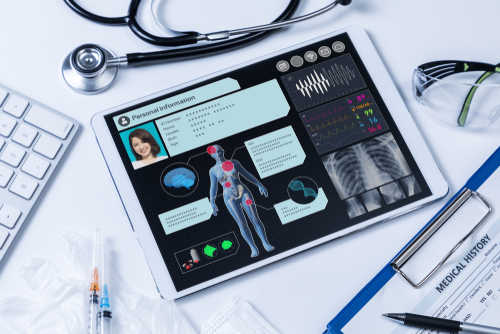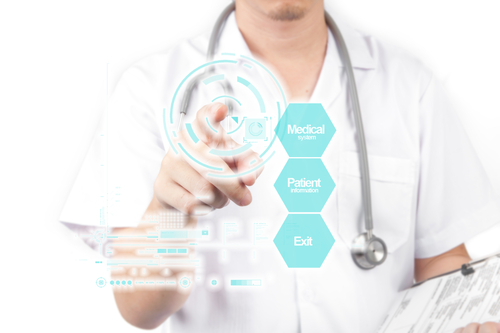
Health informatics, which is also called health information systems, relies on information technology. Workers in the field organize and analyze health records to improve healthcare outcomes. Those workers also develop methods to gather, analyze, and implement patient solutions using existing resources and devices. They must store and retrieve all applicable information regarding patients, treatments, and all eventual outcomes. They build communications protocols within the systems of the facilities where they work. They ensure that doctors, nurses, and other professionals have quick, easy, and efficient access to medical records. The field is growing rapidly, and there are many degree programs available at any education level.
Companies, hospitals, and other care centers make up the chain of facilities that team up to provide care to patients. Each facility in this chain must be able to communicate with all of the other facilities. They must be able to share data quickly, accurately, and securely. The workers, nurses, and doctors have to combine their expertise, training, and experience not only to provide the correct care to each patient but also to improve their techniques and processes. Health informatics personnel study the communication between and the efficiency of all of the facilities in the care chain. Their efforts are the driving force behind process improvement and the maintaining of top-flight care.
Featured Programs
What Is Required to Get a Degree in Health Informatics?

U.S. News and World Report lists the University of Alabama at Birmingham as the pre-eminent school for graduate study of health informatics and healthcare management. The degree program is online, so students from anywhere can study there. The general plan is for students to earn their Master of Science in Health Informatics in 24 months. Surprisingly, students do not need a healthcare background to earn this degree. The university does not require the Graduate Record Examinations, the Graduate Management Admissions Test, or the Miller Analogies test to qualify for graduate study in health informatics. Other schools in the top 10 provide similar options for their students.
As far as undergraduate study is concerned, degree programs at most universities include core classes, major classes, and electives, along with any classes in associated minors, that comprise roughly 120 credits. Students would tailor their junior and senior classes toward their chosen specialty within the field. Some schools even offer combined bachelor’s and master’s programs that allow students to complete both in a shorter time than if they did them separately. Students should consult with the university they plan to attend to find out about their study options.
What are the Degree Options for a Career in Health Informatics?
One of the popular degree programs within the field of healthcare management is the subfield of health informatics. Most positions require either a bachelor’s degree or master’s degree because the field is heavily technical and business-oriented. People who know and understand medical coding, medical billing, and medical database operation will have the best chance to advance in the field. Some of the degrees possible within the field of health informatics include:
- Bachelor of Science in Health Informatics
- Bachelor of Information Technology
- Bachelor of Science Business—Information Technology Management
- Master of Science in Health Informatics
- Master of Information Systems
- Master of Health Informatics
- Master of Nursing Informatics
Additionally, students in medical informatics degree programs can choose to specialize many areas of information technology including:
- Students of bioinformatics focus on software, databases, and analytical tools that process biological information. They must be able to retrieve and share information efficiently, think critically while problem solving, and make decisions based on the best possible patient outcomes. Students may also specialize in nursing informatics, chemical informatics, and dental informatics.
- Students of public health informatics focus on how to use information technology to educate the public. They study computer science and use their computer skills to keep track of current medical research. Also, they learn to design and implement new methods in the field.
- Organizational informatics is the study of both communication within medical organizations and the collation of data used by such organizations. It, too, involves information technology and computer science.
- Social informatics involves research on both the social implications of computerization and the way that information technology affects society’s perception of these systems. Social informatics is based much more on research and theory than other disciplines in the field, yet students who study it might eventually bring about more change than others in different disciplines.
- Clinical informatics involves the study of the ways that information technology affects clinical research and medical education. When coupled with social informatics, it also compliments patient education and perception of the process.
What is the Pay Scale and Job Outlook for Careers Within Health Informatics?

The 2019 median wage for someone in the field of health informatics was $42,630. The top 10% of people in the field earn $71,150 or more. How much one earns is also dependent on that person’s level of education. Someone with an associate degree will earn far less than someone with a bachelor’s degree or master’s degree. In 2019, there were 341,600 jobs extant in the field. The growth rate of 8% is double that of most other jobs, and it means that the field will add 27,328 new jobs through the year 2029. These people work not only in healthcare facilities, such as medical clinics, long-term care facilities, clinics, and doctor’s offices, but they also work in companies that handle health insurance, medical billing, and medical oversight.
The huge growth in the industry comes from the implementation of the electronic health record, or EHR. Medicare, Medicaid, and private insurers use the EHR to transfer patient data swiftly and accurately from one place to another. It is also a simple matter for doctors at many locations to study the patient’s medical records at the same time, making consulting much easier than ever before. The ease with which information can be shared in the 21st century means that healthcare costs will eventually drop. As those costs drop, it might also spur reforms in the U.S. healthcare system.
Executive salaries in the field are roughly double those of their lower counterparts. A director of clinical informatics might make $160,000 or more annually, and even relatively low management positions like charge nurse would ensure a salary of about $85,000 annually. In addition to the growth of the field in general, the salaries are also slated to grow. They might not grow at the same, nearly exponential rate, but grow they will.
All health informatics workers, from the lowest to the highest, must also be responsible for the training of all other healthcare professionals in the use of the relevant computer systems. For them to function the way they should, the users must know what they are doing.
The executives highest up the ladder will also be responsible not only for training in-house staff but also staff members at far-flung places across the country and the world. One of the challenges of the health informatics field is to get computer systems from different countries, particularly those with alphabets different from English, to talk to one another to ensure better patient outcomes worldwide than ever.
Featured Programs
What Is the Difference Between Health Informatics and Health Information Technology?

Health information technology involves maintaining computer systems and their associated programs. Health informatics involves using those programs to achieve better patient outcomes and to understand trends and perceptions in the field of healthcare. They are dependent upon one another for success.
Conclusion
Health informatics is a quickly growing field, and it looks very much like that growth will continue on to 2029 and beyond. As communication technology improves, so will the informatics technology in the field of healthcare. Even today, in walk-in clinics around the country, doctors are working from home yet still providing top-flight care to their patients through video appointments. Many of these clinics also have pharmacies on-site, and this also reduces the time patients must spend at the office.
Patients who might have had to travel hundreds of miles to see a specialist in the past can conference with that specialist in the office of their family doctor. All doctors involved in that patient’s care can count on the informatics professionals to provide the method of sharing all relevant data with all relevant parties. The world of healthcare has never been more forward-looking.
Related Resources: